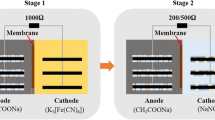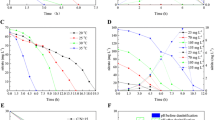Abstract
The treatment of high-salinity, high-nitrate wastewater was investigated in a single expanded granular sludge bed reactor. Complete denitrification was achieved when nitrate concentration was as high as 6,000 mg N/L and the salinity of influent reached 11% NaCl at liquid up-flow velocity of 3.0 m/h, hydraulic retention time of, 24 h and the C/N molar ratio of 2.0. Furthermore, 454-pyrosequencing technology was used to analyze archaea bacterial diversity under high salinity and high nitrate conditions. Results showed that the total number of effective sequences was 5749 consisting of 5678 bacterial sequences and 71 archaea sequences after denoising and filtering out chimeras, which could be affiliated to 5 phylogenetic groups, including Proteobacteria, Firmicutes, Euryarchaeota, Crenarchaeota and unclassified phylum. Although Proteobacteria was the dominant microbial population, two archaea phylogenetic groups-Crenarchaeota and Euryarchaeota were observed in this study.
Similar content being viewed by others
References
Carrera, J., J. A. Baeza, T. Vicent, and J. Lafuente (2003) Biological nitrogen removal of high-strength ammonium industrial wastewater with two-sludge system. Water Res. 37: 4211–4221.
Yoshie, S., T. Ogawa, H. Makino, H. Hirosawa, S. Tsuneda, and A. Hirata (2006) Characteristics of bacteria showing high denitrification activity in saline wastewater. Lett. Appl. Microbiol. 42: 277–283.
Yoshie, S., H. Makino, H. Hirosawa, K. Shirotani, S. Tsuneda, and A. Hirata (2006) Molecular analysis of halophilic bacterial community for high-rate denitrification of saline industrial wastewater. Appl. Microbiol. Biotechnol. 72: 182–189.
Ucisik, A. S. and M. Henze (2004) Biological denitrification of fertiliser wastewater at high chloride concentration. Water SA 30: 191–195.
Kapoor, A. and T. Viraraghavan (1997) Nitrate removal from drinking water-review. J. Environ. Eng. 123: 371–380.
Bassin, J. P., M. Pronk, G. Muyzer, R. Kleerebezem, M. Dezotti, and M. C. M. van Loosdrecht (2011) Effect of elevated salt concentrations on the aerobic granular sludge process: Linking microbial activity with microbial community structure. Appl. Environ. Microbiol. 77: 7942–7953.
Dan, N. P., C. Visvanathan, and B. Basu (2003) Comparative evaluation of yeast and bacterial treatment of high salinity wastewater based on biokinetic coefficients. Bioresour. Technol. 87: 51–56.
Dhamole, P. B., R. R. Nair, S. F. D’Souza, and S. S. Lele (2007) Denitrification of high nitrate waste. Bioresour. Technol. 98: 247–252.
Foglar, L., F. Briski, L. Sipos, and M. Vukovic (2005) High nitrate removal from synthetic wastewater with the mixed bacterial culture. Bioresour. Technol. 96: 879–888.
Liao, R., K. Shen, A. Li, P. Shi, Y. Li, Q. Shi, and Z. Wang (2013) High-nitrate wastewater treatment in an expanded granular sludge bed reactor and microbial diversity using 454 pyrosequencing analysis. Bioresour. Technol. 134: 190–197.
Nair, R. R., P. B. Dhamole, S. S. Lele, and S. F. D’Souza (2007) Biological denitrification of high strength nitrate waste using preadapted denitrifying sludge. Chemosphere 67: 1612–1617.
Chanjae, P. (2000) The Effect of High Salinity on Denitrification of Concentrated Nitrate Wastewaters. M. S. Thesis, University of Nevada, Reno, USA.
Duncan, B. (1995) Effect of Ionic Strength on Denitrification of a High Salt, High Nitrate Brine Simulating Rocky Flats Evaporation Pond Water using Activated Sludge. M. S. Thesis, University of Colorado, Boulder, CO.
Glass, C. H. and J. Silverstein (1999) Denitrification of high nitrate, high salinity wastewater. Water Res. 33: 223–229.
Liu, Z., T. Z. DeSantis, G. L. Andersen, and R. Knight (2008) Accurate taxonomy assignments from 16S rRNA sequences produced by highly parallel pyrosequences. Nucleic Acids Res. 36: e120.
Krause, L., N. N. Diaz, Z. Goesmann, K. S. Scott, T. W. Nattkemper, F. Rohwer, R. Edwards, and J. Stoye (2008) Phylogenetic classification of short environmental DNA fragments. Nucleic Acids Res. 36: 2230–2239.
Petrosino, J. F., S. Highlander, R. A. Luna, R. A. Gibbs, and J. Versalovic (2009) Metagenomic pyrosequencing and microbial identification. Clin. Chem. 55: 856–866.
Kwon, S., T. S. Kim, G. H. Yu, J. H. Jung, and H. D. Park (2010) Bacterial community composition and diversity of a full-scale integrated fixed-film activated sludge system as investigated by pyrosequencing. J. Microbiol. Biotechnol. 20: 1717–1723.
Ye, L., M. F. Shao, T. Zhang, A. H. Y. Tong, and S. Lok (2011) Analysis of the bacterial community in a laboratory-scale nitrification reactor and a wastewater treatment plant by 454-pyrosequencing. Water Res. 45: 4390–4398.
Chou, H. H., J. S. Huang, J. H. Jheng, and R. Ohara (2008) Influencing effect of intra-granule mass transfer in expanded granular sludge bed reactors treating an inhibitory substrate. Bioresour. Technol. 99: 3403–3410.
American Public Health Association (APHA) (1998) Standard methods for the examination of water and wastewater. 17th ed., APHA, NY.
Shah, V., S. Shah, M. S. Kambhampati, J. Ambrose, and N. Smith (2011) Bacterial and archaea community present in the pine barrens forest of long island, NY: Unusually high percentage of ammonia oxidizing bacteria. PLoS ONE 6: e26263.
Davis, L. M. G., I. Martínez, J. Walter, C. Goin, and R. W. Hutkins (2011) Barcoded pyrosequencing reveals that consumption of galactooligosaccharides results in a highly specific bifidogenic response in humans. PLoS ONE 6: e25200.
Cole, J. R., Q. Wang, E. Cardenas, J. Fish, B. Chai, and R. J. Farris (2009) The Ribosomal Database Project: Improved alignments and new tools for rRNA analysis. Nucleic Acids Res. 37: 141–145.
Zhang, T., M. F. Shao, and L. Ye (2011) 454 Pyrosequencing reveals bacterial diversity of activated sludge from 14 sewage treatment plants. ISME. J. 11: 1–11.
Nawrocki, E. P. and S. R. Eddy (2007) Query-dependent banding (QDB) for faster RNA similarity searches. PLoS Comput. Biol. 3: e56.
Aminzadeh, B., A. Torabian, A. A. Azimi, R. Nabi Bidhendi Gh, and N. Mehrdadi (2010) Salt inhibition effects on simultaneous heterotrophic/autotrophic denitrification of high nitrate wastewater. Int. J. Environ. Res. 4: 255–262.
Bae, B. U., Y. H. Jung, W. W. Han, and H. S. Shin (2002) Improved brine recycling during nitrate removal using ion exchange. Water Res. 36: 3330–3340.
Gu, J. D., W. Qiu, A. Koenig, and Y. Fan (2004) Removal of high NO3 —concentrations in saline water through autotrophic denitrification by the bacterium Thiobacillus denitrificans strain MP. Water Sci. Technol. 49: 105–112.
Osaka, T., K. Shirotani, S. Yoshie, and S. Tsuneda (2008) Effects of carbon source on denitrification efficiency and microbial community structure in a saline wastewater treatment process. Water Res. 42: 3709–3718.
Yoshie, S., N. Noda, T. Miyano, S. Tsuneda, A. Hirata, and Y. Inamori (2002) Characterization of microbial community in nitrogen removal process of metallurgic wastewater by PCRDGGE. Water Sci. Technol. 46: 333–336.
Kargi, F. and A. R. Dincer (1998) Saline wastewater treatment by halophile supplemented activated sludge culture in an aerated rotating biodisc contactor. Enz. Microb. Technol. 22: 427–433.
Kapdan, I. K. and B. Boylan (2008) Batch treatment of saline wastewater by — Halanaerobium lacusrosei in an anaerobic packed bed reactor. J. Chem. Technol. Biotechnol. 84: 34–38.
Vyrides, I., H. Santos, A. Mingote, M. J. Ray, and D. C. Stuckey (2010) Are compatible solutes compatible with biological treatment of saline wastewater? Batch and continuous studies using submerged anaerobic membrane bioreactors (SAMBRs). Environ. Sci. Technol. 44: 7437–7442.
Bowman, J. S., S. Rasmussen, N. Blom, J. W. Deming, S. Rysgaard, and T. Sicheritz-Ponten (2012) Microbial community structure of Arctic multiyear sea ice and surface seawater by 454 sequencing of the 16S RNA gene. ISME. J. 6: 11–20.
Hughes, J. B. and J. J. Hellmann (2005) The application of rarefaction techniques to molecular inventories of microbial diversity. In: Leadbetter J. E. (ed.), Methods Enzymol. 397: 292–308.
Roesch, L., R. Fulthorpe, A. Riva, G. Casella, A. Hadwin, and A. Kent (2007) Pyrosequencing enumerates and contrasts soil microbial diversity. ISME. J. 1: 283–290.
Hu, M., X. H. Wang, X. H. Wen, and Y. Xia (2012) Microbial community structures in different wastewater treatment plants as revealed by 454-pyrosequencing analysis. Bioresour. Technol. 117: 72–79.
Zhao, G., F. Ma, L. Wei, and H. Chua (2012) Using rice straw fermentation liquor to produce bioflocculants during an anaerobic dry fermentation process. Bioresour. Technol. 113: 83–88.
Yoshie, S., N. Noda, T. Miyano, S. Tsuneda, A. Hirata, and Y. Inamori (2001) Microbial community analysis in the denitrification process of saline-wastewater by denaturing gradient gel electrophoresis of PCR-amplified 16S rDNA and the cultivation method. J. Biosci. Bioeng. 92: 346–353.
Author information
Authors and Affiliations
Corresponding author
Rights and permissions
About this article
Cite this article
Liao, R., Li, Y., Wang, Z. et al. 454 pyrosequencing analysis on microbial diversity of an expanded granular sludge bed reactor treating high NaCl and nitrate concentration wastewater. Biotechnol Bioproc E 19, 183–190 (2014). https://doi.org/10.1007/s12257-013-0387-0
Received:
Revised:
Accepted:
Published:
Issue Date:
DOI: https://doi.org/10.1007/s12257-013-0387-0




